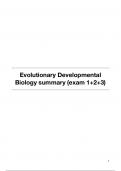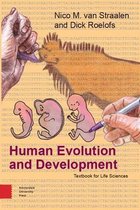Evolutionary Developmental
Biology summary (exam 1+2+3)
1
,Lecture 1 | EDB introduction 3
Lecture 2 | The story of our ancestors 3
Lecture 3 | Migrations & hybridizations 6
Lecture 4+5 | Phylogenetic reconstruction 10
Lecture 6 | Genetics 12
Lecture 7 | Partner choice & sexuality 14
Lecture 8 | Model organisms 17
Lecture 9+10 | Genetic variation and selection 19
Lecture 11+12 | Neutral evolution and genetic distance 23
Lecture 13+14 | Cleavage patterns, germ layers & body axes 25
Lecture 15 | Molecular evolution of body plans 29
Lecture 16 | Bipedalism 32
Lecture 17 | Gill arches 33
Lecture 18 | The heart 35
Lecture 19 | Kidney and lung 36
Lecture 20 | Heterochrony 38
Lecture 21 | Developmental plasticity 40
Lecture 22 | Aging and life history evolution 42
Lecture 23 | Journal club: Sex di erence in pathology of the aging gut
mediates the greater response of female lifespan to dietary restriction 45
Lecture 24 | Evolution of the brain 46
Lecture 25 | Language and cognition 49
Lecture 26+27 | Defenses & pathogen evolution 50
Lecture 28 | Evolution of sociality 55
Lecture 29 | Cultural evolution 57
Lecture 30+31 | Evolutionary mismatches & modern society 60
2
ff
,Lecture 1 | EDB introduction
- Charles Darwin (1859), On the Origin of Species
- Evolution: change in heritable characteristics of biological populations over successive
generations
- Natural selection:
1. Variation in reproductive success
2. Variation in trait of interest
3. Correlation between trait and reproductive success
4. Trait is heritable
- Survival of the ttest
- ~1920-1950: modern evolutionary synthesis
> Merging natural selection with genetics
- Darwinism + modern synthesis (Neo-Darwinism) + extended synthesis
- Since early 1990s: Darwinian/evolutionary medicine
- Types of thinking:
- Typological — ‘normal’/average condition is most important aspect to consider
- Population — understanding variation in a population
> Patterns of variation in space+time
> See evolution ‘live’ in action (e.g. covid-19 or antibiotic resistance)
> Heritable traits with standing genetic variation and possibly subject to selection
in humans
> Behavior, physiology, morphology, life-cycle traits
> Not everything is adaptive
> When is something adaptive?
1. Observing natural selection (experimental evolution in microorganisms/
nematodes/insects)
2. Perturbing the trait (move trait away from its optimum)
3. Trait is produced only when it serves a function (e.g. spine development
in Daphnia when predators are present)
> Most of these are not possible in humans -> model organisms +
association studies / phylogenetic analyses
- Tree thinking — understanding the position of a species/trait in phylogenetic tree
> Expresses relationship among organisms and their evolutionary history
Lecture 2 | The story of our ancestors
- Homo sapiens (‘knowledgeable man’)
- Kingdom: Animalia
- Phylum: Chordata
- Subphylum: Vertebrata
- Class: Mammalia
- Order: Primates
- Family: Hominidae (human, chimpanzee, gorilla)
- Subfamily: Homininae (~7 Mya)
> Bipedalism, brain size, family structure and sexuality
> Homo sapiens is only species alive
- Genus: Homo
- ~4100 Mya — Origin of life
- ~18 Mya — Hominidae (great apes)
- Primates are our ‘extended family’; Hominidae-speci c characteristics are: no tail, remarkably
long periods of nursing and adolescence, sexual dimorphism
3
fi fi
, - Homininae are our closest relatives
> Many splits and dead ends (cladogenesis; new species emerge from side branches,
while main branch continues/dies out)
> Anagenesis: gradual evolution of a species; main branch evolves in straight line
into a new species, without splitting; only 1 species is alive at a time
> Precise phylogeny still debated
- All old fossil hominins are found in Africa (mostly East Africa, Great Rift Valley)
- Ecological context of hominin evolution:
- African rain forest gave way to savannah 10 Mya -> novel ecological niche (terrestrial
instead of arboreal lifestyle demanded adaptation)
- Important hominin species:
- Australopithecus afarensis
- Lived in Africa, ~3.5 Mya
- Ancestor of all Homo species
- Mosaic of ancestral and derived traits
- Homo erectus
- Lived in Africa and Asia, ~1.5 Mya
- African H. erectus ancestor of H. sapiens
- Homo neanderthalensis
- Lived in Europe and Asia, 600-30 kya
- Similarities to H. sapiens; extinct sister clade
- From early hominins to Australopithecus (road towards bipedalism):
- Ardipithecus ramidus (‘Ardi’) (5.8-5.2 Mya) was bipedal, but still with primitive traits:
most notably, foot with large hallux abduction
- In Australopithecus, bipedalism was accomplished
> Step-wise re-organization of entire skeleton
> Basis for evolution of other ‘human’ adaptations
- Bipedalism freed the hands (allowing availability for taking food to home base),
enhances overview of surroundings (predators more easily spotted), e cient way of
moving forward without proceeding too fast, straight-up posture reduces quantity of
absorbed solar radiation while upper body is able to cool o by using air ow (better
heat regulation in hot climate)
- Lucy (A. Afarensis, 3.2 Mya, excavated 1974 in Ethiopia) was most complete Australopithecus
fossil at that time
- First to display characteristics of bipedalism AND small brain -> settled ‘brain rst’ vs
‘bipedalism rst’ debate
- Mosaic evolution in Australopithecus:
- Not all humanlike traits evolved at same time
- Apomorphic (derived, newly evolved) vs plesiomorphic (ancestral)
- Skull shape and brain volume largely plesiomorphic
- Dental arcade changed from U-shaped to parabolic and became shorter
- Reduction in canine teeth size in Australopithecus, but still signi cant sexual
dimorphism
> Teeth di erence ~ diet
> Robust (herbivore) vs gracile (omnivore) species could exist
simultaneously; robust all became extinct
- A. Afarensis had a strong sexual dimorphism in body size
> Sexual dimorphism due to living in harems (single dominant male with several females ->
competition among males -> dimorphism due to intra-sexual selection)
> Baboons are polygynous (living in harem groups), very dimorphic
> Gibbons are monogamous, not dimorphic
> Dimorphism gradually disappeared
4
fi ff ff fi ffi fl fi






